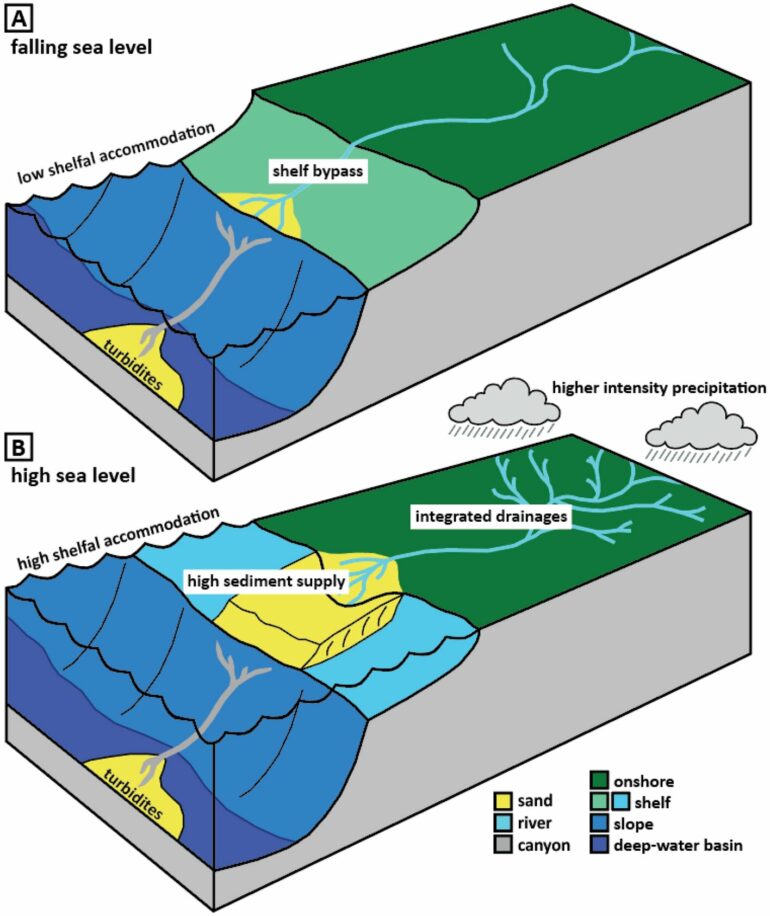About 34 million years ago, Earth began to cool dramatically, transforming the climate from greenhouse to icehouse and causing sea levels to fall. As more land was exposed to weathering forces, copious amounts of sediment likely sloughed off continents into the oceans, bound for the deep seafloor.
So, when Montana State University assistant professor Zachary Burton, then a doctoral student at Stanford University, set out to see how that sediment had accumulated as submarine layers of sand and mud, he expected there would be much to discover.
To his surprise, he instead found—nothing.
The journal Earth-Science Reviews has published Burton’s findings, which reveal the existence of a global unconformity—or gap in the rock record—around the edges of every continent at the time of the pivotal greenhouse-to-icehouse climatic transition.
In addition to challenging conceptual models widely used for the past half-century about the relationships between sea levels and sediment movement in the deep oceans, Burton said his discovery has left him and his co-authors wondering: Where in the world did all the sediment go?
“This is something we weren’t at all expecting to discover,” said Burton, who recently joined the faculty of MSU’s Department of Earth Sciences in the College of Letters in Science. “We’d set out to find lots of deposition, lots of sand. Instead, we’re finding a gap in the rock record. That sediment is missing.”
The paper began as part of Burton’s doctoral thesis, for which he conducted a massive review of existing data on deep-sea sediments deposited during various extreme climatic periods in Earth’s history.
Last year, Scientific Reports published another article based on a different chapter of Burton’s thesis. It described the presence of large volumes of sand deposited along the margins of nearly all continents when sea levels were high during a very warm climate interval about 50 million years ago. It was another unexpected finding that didn’t conform to traditional ideas about how ocean sediments are deposited.
Burton said further research is needed to explain the results of both studies, and to expand understanding of global controls on marine sedimentary systems in the past, present and future.
“Why do we care about sand moving out in the ocean? It’s not only to understand what happened millions of years ago, but also to understand the contemporary world and what’s going on under the ocean surface,” he said.
For example, he said, geologists employed by oil companies study the distribution of sands in sedimentary basins, which often contain oil. Some scientists are investigating the suitability of sand deposits as reservoirs for sequestering carbon. And a better grasp of submarine processes and hazards is necessary to protect undersea cables, as well as to determine risks to other types of offshore infrastructure, such as wind farms or oil and gas platforms.
As a new MSU faculty member, Burton plans to continue studying the impacts of historic climate changes and other catastrophic events with his students. In the spring, he hopes to offer a special course for upper-level undergraduate and graduate students to investigate what happened after an especially notorious moment in Earth’s natural history: the Chicxulub meteor impact that killed the dinosaurs 66 million years ago.
Burton said the research-intensive seminar will follow a similar approach to his just-published paper. It will involve looking at data from marine settings along the world’s continental margins to compile a catalog of sediments centered around the dinosaur-killing impact.
“The motivation is to understand the responses of these sedimentary systems to catastrophic perturbations, such as extreme climate change or a world-altering meteorite impact,” he said. “For students, it’s an opportunity to contribute to a research question that hasn’t really been answered.”
As for the newly published paper, Burton said he expects it to capture some attention.
“We put out a paper that hopefully gets people scratching their heads,” he said. “It’s good to keep us all thinking.”
More information:
Zachary F.M. Burton et al, Global Eocene-Oligocene unconformity in clastic sedimentary basins, Earth-Science Reviews (2024). DOI: 10.1016/j.earscirev.2024.104912
Provided by
Montana State University
Citation:
Professor helps discover global gap in geologic record (2024, October 9)



